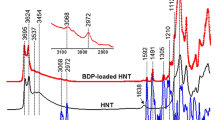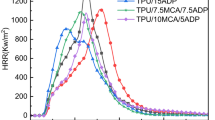Abstract
This study focused on the influence of different filler loadings on the elongation at break and flammability properties of the PA11/FR/HNTs nanocomposites. Polyamide 11 (PA11)/flame-retardant (FR) additives/halloysite nanotubes (HNTs) nanocomposites were melt compounded via twin-screw extrusion for all the compositions. Three FR additive loadings (15, 20, and 25 wt%) and three HNTs loadings (2.5, 5, and 10 wt%) were selected. The formula with 25 % FR and 2.5 % HNT had the lowest additives content and the highest elongation at break of 10.22 % among all UL-94 V-0 rated formulas. A homogeneous dispersion of HNTs in PA11 matrix was observed by transmission electron microscopy. Differential scanning calorimeter measurements indicated that HNTs behaved as nucleating agents by accelerating the rate of crystallization, thus increasing crystallization temperature. The young’s modulus of the PA11 nanocomposites was enhanced with the addition of HNTs. Micro-scale combustion calorimeter results demonstrated that the addition of HNTs also decreased the peak heat release rate of the nanocomposites. These results indicate the effectiveness of HNTs on the mechanical, thermal, and flame-retardant performance of PA11/FR/HNTs nanocomposites.









Similar content being viewed by others
References
Joussein E, Petit S, Churchman J et al (2005) Halloysite clay minerals—a review. Clay Miner 40:383–426
HNT (2014) Halloysite Nanotubes. http://www.naturalnano.com/index.php?option=com_content&task=view&id=17&Itemid=45. Accessed 3 Sept 2014
Prashantha K, Lacrampe MF, Krawczak P (2011) Processing and characterization of halloysite nanotubes filled polypropylene nanocomposites based on a masterbatch route: effect of halloysites treatment on structural and mechanical properties. Express Polym Lett 5:295–307
Du M, Guo B, Jia D (2010) Newly emerging applications of halloysite nanotubes: a review. Polym Int 59:574–582. doi:10.1002/pi.2754
Liu C, Luo YF, Jia ZX et al (2011) Enhancement of mechanical properties of poly (vinyl chloride) with polymethyl methacrylate-grafted halloysite nanotube. Express Polym Lett 5:591–603
Bulter S, Kim G, Koo JH et al (2011) Flame retardant polyamide 11–halloysite nanotube nanocomposites: mechanical, thermal, and flammability characterization. In: Proceedings of 43rd international SAMPE technical conference, Ft. Worth, TX, pp 17–20
Guo B, Zou Q, Lei Y et al (2009) Crystallization behavior of polyamide 6/halloysite nanotubes nanocomposites. Thermochim Acta 484:48–56
Lecouvet B, Gutierrez JG, Sclavons M, Bailly C (2011) Structure–property relationships in polyamide 12/halloysite nanotube nanocomposites. Polym Degrad Stab 96:226–235
Marney DCO, Russell LJ, Wu DY et al (2008) The suitability of halloysite nanotubes as a fire retardant for nylon 6. Polym Degrad Stab 93:1971–1978
Prashantha K, Schmitt H, Lacrampe MF, Krawczak P (2011) Mechanical behaviour and essential work of fracture of halloysite nanotubes filled polyamide 6 nanocomposites. Compos Sci Technol 71:1859–1866
Deng S, Zhang J, Ye L (2009) Halloysite–epoxy nanocomposites with improved particle dispersion through ball mill homogenisation and chemical treatments. Compos Sci Technol 69:2497–2505
Liu Y, Feng Z, Wang Q (2009) The investigation of intumescent flame-retardant polypropylene using a new macromolecular charring agent polyamide 11. Polym Compos 30:221–225
Wohlers T (2014) Wohlers Report 2014: 3D printing and additive manufacturing state of the industry. Wohlers Associates Inc., Fort Collins
Koo JH (2006) Polymer nanocomposites: processing, characterization, and applications. McGraw-Hill Professional, NY
Johnson B, Koo JH (2012) Analysis of the selective laser sintering process using polymer nanocomposites. In: Proceedings of SAMPE 2012 ISSE, Baltimore, MD, 21–24 May 2012
Fornes TD, Yoon PJ, Hunter DL et al (2002) Effect of organoclay structure on nylon 6 nanocomposite morphology and properties. Polymer 43:5915–5933
Huang S, Wang M, Liu T et al (2009) Morphology, thermal, and rheological behavior of nylon 11/multi-walled carbon nanotube nanocomposites prepared by melt compounding. Polym Eng Sci 49:1063–1068
Gaikwad S, Tate JS, Theodoropoulou N, Koo JH (2013) Electrical and mechanical properties of PA11 blended with nanographene platelets using industrial twin-screw extruder for selective laser sintering. J Compos Mater 47:2973–2986. doi:10.1177/0021998312460560
Lao SC, Yong W, Nguyen K et al (2010) Flame-retardant polyamide 11 and 12 nanocomposites: processing, morphology, and mechanical properties. J Compos Mater 44:2933–2951
Markarian J (2005) Flame retardants for polyamides—new developments and processing concerns. Plast Addit Compd 7:22–25. doi:10.1016/S1464-391X(05)00357-0
Schmitt E (2007) Phosphorus-based flame retardants for thermoplastics. Plast Addit Compd 9:26–30. doi:10.1016/S1464-391X(07)70067-3
Waaijers SL, Kong D, Hendriks HS et al (2013) Persistence, bioaccumulation, and Toxicity of Halogen-free flame retardants. In: Whitacre DM (ed) Reviews of environmental contamination and toxicology. Springer, New York, pp 1–71
Lao SC, Wu C, Moon TJ et al (2009) Flame-retardant polyamide 11 and 12 nanocomposites: thermal and flammability properties. J Compos Mater 43:1803–1818
Underwriters Laboratories (1996) UL-94: Tests for flammability of plastic materials for parts in devices and appliances.
Guo B, Zou Q, Lei Y, Jia D (2009) Structure and performance of polyamide 6/halloysite nanotubes nanocomposites. Polym J 41:835–842
Hedicke-Höchstötter K, Lim GT, Altstädt V (2009) Novel polyamide nanocomposites based on silicate nanotubes of the mineral halloysite. Compos Sci Technol 69:330–334
Flynn JH, Wall LA (1966) A quick, direct method for the determination of activation energy from thermogravimetric data. J Polym Sci B 4:323–328. doi:10.1002/pol.1966.110040504
Hao A, Zhao H, Chen JY (2013) Kenaf/polypropylene nonwoven composites: the influence of manufacturing conditions on mechanical, thermal, and acoustical performance. Compos Part B Eng 54:44–51
Jiang W, Sun L, Hao A et al (2012) Nano-particles modified cellulose films regenerated from ionic liquid solutions. J Nanostructured Polym Nanocomposites 8:71–77
Acknowledgements
The authors would like to thank KAI, LLC for sponsoring this project; and Dr. G. Wissler of 21st Century Polymers Inc. for preparing the formulations.
Author information
Authors and Affiliations
Corresponding author
Rights and permissions
About this article
Cite this article
Hao, A., Wong, I., Wu, H. et al. Mechanical, thermal, and flame-retardant performance of polyamide 11–halloysite nanotube nanocomposites. J Mater Sci 50, 157–167 (2015). https://doi.org/10.1007/s10853-014-8575-7
Received:
Accepted:
Published:
Issue Date:
DOI: https://doi.org/10.1007/s10853-014-8575-7




